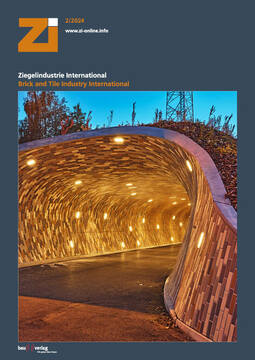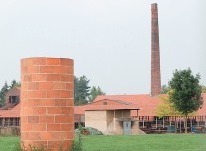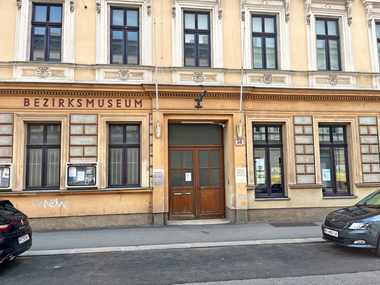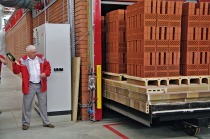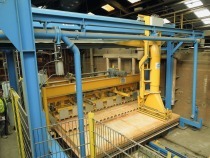“Go fire some bricks” - Interview on the 40-year history of Instalat
The Dutch specialist for ovens, burners and control systems Instalat was founded 40 years ago. The founder, Hans Liefrink, celebrated his 80th birthday in November 2023 and still comes into his office two days a week to work. The ZI editorial team visited him at the company headquarters in Wijchen to talk about Instalat and the past 40 years in the brick and tile industry. Liefrink also reveals how a car led him into the brick industry.
Founding story
How did you come to found Instalat in 1983?
Hans Liefrink: It wasn’t planned and I came to bricks more by chance. I completed my vocational training at an engineering school in Arnhem, in the mechanical engineering department. After completing two years of military service at the NATO airbase in Hessisch Oldendorf near Hanover in Germany, I applied to two companies. The companies were Technisch Centrum Waalsteen (TCW - Technical Service Waalsteen), a consultancy firm for the brick industry near Nijmegen, and a company for gas heating in homes. I received an offer from both on the same day. I decided in favour of TCW. The deciding factor was the car I was offered as a company car. That was something very special at the time. Very few people owned a car or had access to one. I didn’t even have a driving licence myself, which I managed to get in a few weeks. The other company was very annoyed. They shouted after me: “ga jij maar steentjes bakken” (you go and burn stones). I’ve remembered that for the rest of my life and I’ve mainly done it for effect.
Were you already familiar with brick production back then?
HL: At that time, I had no idea how bricks were made. On my first visit to a brickworks, with a Hoffmann kiln, open-air drying, brick transport by tractor and horse, a hand-laid line with 20 employees and a production capacity of 3,000 bricks per day, I was very disappointed. I had to work there for three months as a manager, even though I had no specialised knowledge. Every evening I had to count how many bricks were produced, cut open and placed in the kiln, and note down the results. I wouldn’t stay in this industry for long, I thought. But things turned out differently.
TCW was a very suitable place to train in the brick industry because of its profile. On the one hand, we had to deal with many problems in the areas of drying, firing and production. On the other hand, new plants were built or existing plants were converted. I learnt a lot during my time there.
What motivated you to found Instalat?
HL: Unfortunately, there were serious technical differences between the director and myself. He was in favour of chamber kilns, I was in favour of tunnel kilns. There were also many other problems between us. So after twelve years, I decided to look for another job. I ended up working for a company that manufactured various products near Nijmegen: spray booths for cars, small periodic ovens for the pot industry and gas systems and pipes for companies including Karl Walter Hannover. After a few years, I took over the management of the company. But the economic crisis at the beginning of the 1980s was too great a challenge for this company without a financial cushion. I had to file for bankruptcy.
The question now was: what next? Should I look for a new job or set up a new company? Instalat was born out of this decision. With financial help from a well-known brickworks owner and Karl Walter Hannover, among others, Instalat was founded on 26 October 1983. My share in the company was 25 per cent.
Company history
What did you initially manufacture at Instalat?
HL: In the early years, we mainly manufactured and sold burner systems and gas pipework for tunnel kilns. Initially, we also manufactured machine parts for various companies. However, when you are dependent on large companies, you have to make a new offer at a new price every year. As we could not increase the price to the same extent as our costs rose, our profit fell from year to year. We therefore decided to stop producing machine parts and specialise in burner systems. Some of the orders for this came from Karl Walter Hannover. We then focussed on converting dryers in the Netherlands and Belgium, with individual burners instead of air heaters. We also manufactured and sold many other installations for ovens and dryers. Unfortunately, Karl Walter went bankrupt in 1988.
How did you compensate for the loss of this important partner?
HL: I managed to take over Walter’s shares so that Instalat could continue. But how was the Karl Walter company to continue? A new company, Walter-Craven Ceramic Project, was founded with Craven Fawcett, which was very successful until 1996. In 1996, the company became 100 per cent owned by Instalat. After several successful orders for the construction of tunnel kilns, competition with a German company intensified. When this competitor undercut Walter-Craven Ceramic Projekt with dumping prices for a kiln project in the Netherlands, there was no longer enough work for the workforce. So we decided to close Walter-Craven Ceramic Projekt and transfer its expertise to Instalat. This is how tunnel kiln construction came to the Netherlands. Instalat was based in Nijmegen North at the time. The municipality of Nijmegen decided to build flats there and made us an offer to buy the land. It came at the right time. We agreed and were able to use the proceeds to acquire all of Instalat’s shares. The company has been free of shareholders since 2002 and is in the black. In the same year, we also opened the new headquarters in Wijchen.
When was the electrical department opened at Instalat?
HL: Initially, we received electronic components and the controls for ovens and dryers from Friedrichs in Laubach. They also supplied Karl Walter Ofenbau. Control systems from Friedrichs were widely used in the Netherlands at the time. However, the company was not doing well economically and had been making losses for years. In 1985, I joined the company as a shareholder with a 20 per cent stake after Karl Walter asked me.
However, Friedrichs’ products were very expensive. That’s why we founded our own electronics company, Instalat Elektro, under the umbrella of Instalat. We sold the shares in Friedrichs. At the beginning, in 1988, Instalat’s electrical department was still making huge losses. My shareholders wanted to close the department, but I argued against it, arguing that I couldn’t supply a firing system, oven or dryer without a control system. We invested a lot of money in the first few years. Instalat Elektro is now doing very well.
Instalat also manufactures periodic ovens. When did Instalat start in this product segment?
HL: The decision to produce periodic kilns was made in 1988, when we built the first large kiln for the Jansen und Söhne roof tile factory in Brüggen in Germany, which produced accessories for Röben. The second periodic kiln was later delivered to Denmark. It is still running after 35 years.
The largest order for periodic kilns came in 2002, when we supplied 18 kilns for reducing firing to Janssen Dings in Tegelen, the Netherlands. To date, Instalat has supplied a total of approx. 100 larger kilns, of which approx. 70 are designed for reducing firing. In Northern Europe, Belgium, the Netherlands, Germany and Denmark there are many reduction kilns from us.
Current situation
How is the demand for Instalat products and services currently developing? Are the war in Ukraine, the gas crisis and currently the construction crisis in Germany and Europe having an impact on demand and sales?
HL: Demand is mainly focused on optimising existing kilns and dryers. There are currently few enquiries for the construction of tunnel kilns and dryers. This could be better, but we will at least be in the black in 2023. It remains to be seen how things will continue next year. We have a big enough cushion to cope with several bad years. In my experience, markets always run in cycles of around five years.
Which markets are important for Instalat?
HL: Our most important markets are in the Netherlands, Belgium, Germany, Denmark, England and Eastern Europe. There, in Slovakia, Hungary, etc., we work primarily with the building materials manufacturer Leier. We also used to supply a lot to Russia, Ukraine and Iran. But the market in the first two countries mentioned is dead. In Iran, stove manufacturers from China are very active and have largely taken over the market. The Dutch market could contract in the coming years, as residential construction is under great pressure. It is true that 90,000 homes are to be built in the Netherlands every year for the next ten years. However, this target will not be met. Only around 70,000 homes are expected to be built in 2023. I expect even lower completion figures for the coming years. This is because the political goal of significantly reducing nitrogen emissions in the Netherlands is standing in the way of housing construction.
The availability of skilled labour and skilled workers in Germany is decreasing and poses an increasing challenge for the brick and tile industry and its suppliers. What is the situation at Instalat?
HL: We are facing the same problem at Instalat, especially in the workshop, where the lack of new recruits is a huge problem. Many long-serving employees have recently retired or will be retiring soon. We have no fluctuation. Those who start at Instalat stay here. Almost all colleagues have celebrated their 25th anniversary with the company. There is a friendly atmosphere, like in a family business. I’m also sociable and only cause a few problems. My successor Frank Ernst is an example of how long I have been with the company. He has been with Instalat since 1987. He did his apprenticeship here straight after finishing school and stayed on, making it all the way to Managing Director. Instalat wouldn’t work without him.
The future
What are the plans for the future development of Instalat?
HL: We need to expand our sales area and open up new markets, e.g. in Asia and the Middle East. That’s why a new employee will be joining us this year to support Frank Ernst. In this context, we also have plans to expand our product range. Discussions are currently underway with a company about the use of heat pumps for dryers. We are also running a trial system with a heat pump, for which we have supplied the complete control system.
Which technology for CO2-free kiln heat supply do you think will prevail? Green hydrogen or green electric drying? Is Instalat conducting research in this direction?
HL: In my opinion, electric heating for larger ovens is still a long way from being technically feasible. I think that the use of hydrogen for kilns and dryers will become established in the coming decades. There is no other option. The thermal utilisation of gas and oil will and must be phased out. The environmental impact of CO2 and NOx must be reduced. Furthermore, from the perspective of the raw materials industry, it is wrong to burn gas and oil. Gas, for example, can be used to produce fertiliser and many other essential substances.
However, green hydrogen is not yet available. Green electrical energy for the production of green hydrogen is also not yet available in sufficient quantities. Green hydrogen is also currently five times more expensive than natural gas. The hydrogen available in the Netherlands is 90 percent grey hydrogen, which is produced from natural gas. The total costs for its production are and remain twice as high as natural gas. This is why grey hydrogen is irrelevant for the brick and tile industry.
A brickworks can only produce a small proportion of the energy it needs from its own resources, such as self-installed and operated windmills and solar panels. This can be demonstrated with a brief example: A tunnel kiln consumes approximately 500 m3 of natural gas per hour or 5000 kilowatt hours. To produce the equivalent amount of hydrogen for heating, twice as much electrical energy is required, i.e. 10,000 kWh. Firstly, this requires a lot of windmills and even more solar panels, but secondly, the wind doesn’t always blow and the sun often lets us down. In my opinion, the solution lies in a combination of many different factors for the production of electrical energy and therefore hydrogen: in addition to larger solar installations and windmills, nuclear energy is certainly also needed. This is currently being actively pursued in the Netherlands. Until sufficient nuclear energy is available, we will remain dependent on natural gas and oil. Currently, only 14 per cent of total energy consumption in the Netherlands is covered by green energy.
The distribution of hydrogen, on the other hand, is not so difficult in my opinion; in many countries, the existing gas pipelines are suitable for hydrogen after a few modifications. This is because hydrogen contains only a third of the energy of natural gas per cubic metre. Therefore, higher pressures are required for transport and storage, and the pipelines must be adapted accordingly.
Instalat is prepared for the use of hydrogen. We have developed a high-speed burner that works with natural gas and hydrogen.
Instalat itself is already 100 per cent powered by CO2-free electricity, supplied by a total of 330 solar panels.
What will happen next with Instalat?
HL: This is a problem, and I don’t yet know the solution. There is no immediate pressure to act. Instalat and Instalat Elektro are organised as a corporation in such a way that operations could continue without me. But I would like to see management and company ownership in one hand. It would be nice if we could find a private individual with the right expertise and the right resources.
And what are you going to do?
HL: Until the age of 74, I was one hundred per cent committed to the company. After that, I gradually cut back on my work due to age and strength. I am now mostly retired and only come into the company two days a week. At the same time, I’ve taken up an old hobby again, playing table tennis. I do it every day now and it keeps me young. I also do a lot of research into the history of Dutch brickmaking. I also look after my garden, my stamp collection and spend time with my family.

